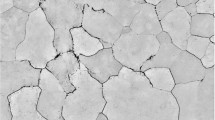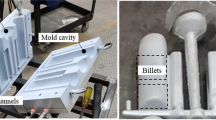Abstract
To solve the difficulties associated with integral precise extrusion forming for complex components of magnesium alloy, Deform-3D finite element simulation software was used to conduct numerical analyses for the forming process. Different extrusion schemes were used for determining the overall extrusion difficulties associated with special-shaped thin-walled complex components of magnesium alloy. The effects of a preformed blank on the filling and formation of folding defects in the forming process were studied. Based on the principle of minimum energy in the process of plastic deformation and the law of least resistance, volume predistribution and equal distance flow quantitative compensation methods were put forward. These methods were used to optimize the size and structure of the preform, forming a uniform material flow distribution. They also enabled one to manifest a uniform material flow velocity distribution, reduce the forming load, and avoid the creation of folding and filling defects during the final forming, for the realization of an efficient and reliable preform optimization design for magnesium alloy profiled complex components. The results obtained from a forming test, microstructure and mechanical properties test showed that the mechanical properties of the extruded component all met the service indexes. This design method can provide a theoretical reference for preforming design of profiled complex components.












Similar content being viewed by others
References
L.H. Lang, A.J. Xu, and F. Li, Precision Forging Technological Optimization for 7075 Aluminum Alloy Complex Component with Limbs, JOM, 2012, 64(2), p 309–315. https://doi.org/10.1007/s11837-012-0243-2
C. Lv, L. Zhang, Z. Mu, Q. Tai, and Q. Zheng, 3D FEM Simulation of the Multi-stage Forging Process of a Gas Turbine Compressor Blade, J. Mater. Process. Technol., 2008, 198(1–3), p 463–470. https://doi.org/10.1016/j.jmatprotec.2007.07.032
J.J. Sheu and C.H. Yu, Preform and Forging Process Designs Based on Geometrical Features Using 2D and 3D FEM Simulations, Int. J. Adv. Manuf. Technol., 2009, 44(3–4), p 244–254. https://doi.org/10.1007/s00170-008-1834-5
J. Knust, F. Podszus, M. Stonis, B.A. Behrens, L. Overmeyer, and G. Ullmann, Preform Optimization for Hot Forging Processes Using Genetic Algorithms, In. J. Adv. Manuf. Technol., 2017, 89(5–8), p 1623–1634. https://doi.org/10.1007/s00170-016-9209-9
Y. Shao, B. Lu, D.K. Xu, J. Chen, H. Ou, H. Long, and P.Y. Guo, Topology-Based Preform Design Optimization for Blade Forging, Int. J. Adv. Manuf. Technol., 2016, 86(5–8), p 1593–1605. https://doi.org/10.1007/s00170-015-8263-z
G. Tao, Y.G. He, and Y.L. Liu, Backward Tracing Simulation of Precision Forging Process for Blade Based on 3D FEM, Trans. Nonferrous Met. Soc. China, 2006, 16, p s639–s644. https://doi.org/10.1016/S1003-6326(06)60269-0
S.R. Lee, Y.K. Lee, C.H. Park, and D.Y. Yang, A New Method of Preform Design in Hot Forging by Using Electric Field Theory, Int. J. Mech. Sci., 2002, 44(4), p 773–792. https://doi.org/10.1016/S0020-7403(02)00003-6
J. Cai, F. Li, and T. Liu, Preform Design for Large-Sized Frame Forging of Ti-Alloy Based on 3-D Electrostatic Field Simulation and Geometric Transformation, J. Mater. Eng. Perform., 2011, 20(9), p 1491–1496. https://doi.org/10.1007/s11665-010-9811-1
D.C. Ko, D.H. Kim, B.M. Kim, and J.C. Choi, Methodology of Preform Design Considering Workability in Metal Forming by the Artificial Neural Network and Taguchi Method, J. Mater. Process. Technol., 1998, 80–81, p 487–492. https://doi.org/10.1016/S0924-0136(98)00152-6
M. Poursina, J. Arvizian, and C. Antonio, Optimum Pre-form Dies in Two-Stage Forging, J. Mater. Process. Technol., 2006, 174(1/3), p 325–333. https://doi.org/10.1016/j.jmatprotec.2006.01.015
Y. Kawamura and M. Yamasaki, Formation and Mechanical Properties of Mg97Zn1RE2 Alloys with Long-Period Stacking Ordered Structure, Mater. Trans., 2007, 48(11), p 2986–2992. https://doi.org/10.2320/matertrans.MER2007142
Acknowledgments
The authors would like to gratefully acknowledge the support of the National Natural Science Foundation of China (51675492) and Natural Science Foundation of Shanxi Province (201801D121106)
Author information
Authors and Affiliations
Corresponding author
Additional information
Publisher's Note
Springer Nature remains neutral with regard to jurisdictional claims in published maps and institutional affiliations.
Rights and permissions
About this article
Cite this article
Li, X., Hu, H., Zhang, Z. et al. Precise Forming of Complex Magnesium Alloy Components Based on Finite Element Method and Quantitative Preforming Design. J. of Materi Eng and Perform 29, 5139–5146 (2020). https://doi.org/10.1007/s11665-020-05014-2
Received:
Revised:
Published:
Issue Date:
DOI: https://doi.org/10.1007/s11665-020-05014-2




